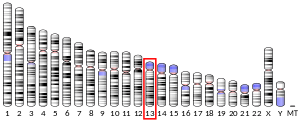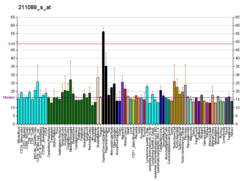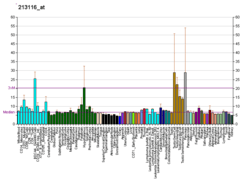NEK3
Serine/threonine-protein kinase Nek3 is an enzyme that in humans is encoded by the NEK3 gene.[5][6][7]
In Aspergillus nidulans, lack of the serine/threonine kinase NimA (never in mitosis A) results in cell cycle arrest in G2, while overexpression causes the premature onset of mitotic events. The protein encoded by this gene is similar in sequence to the Aspergillus nidulans protein and may therefore play a role in mitotic regulation. However, the encoded protein differs from other NimA family members in that it is not cell cycle regulated and is found primarily in the cytoplasm. Three transcript variants have been found for this gene, but the full-length nature of only two of them has been characterized.[7]
References
- 1 2 3 GRCh38: Ensembl release 89: ENSG00000136098 - Ensembl, May 2017
- 1 2 3 GRCm38: Ensembl release 89: ENSMUSG00000031478 - Ensembl, May 2017
- ↑ "Human PubMed Reference:".
- ↑ "Mouse PubMed Reference:".
- ↑ Schultz SJ, Nigg EA (Feb 1994). "Identification of 21 novel human protein kinases, including 3 members of a family related to the cell cycle regulator nimA of Aspergillus nidulans". Cell Growth Differ. 4 (10): 821–30. PMID 8274451.
- ↑ Schultz SJ, Fry AM, Sutterlin C, Ried T, Nigg EA (Oct 1994). "Cell cycle-dependent expression of Nek2, a novel human protein kinase related to the NIMA mitotic regulator of Aspergillus nidulans". Cell Growth Differ. 5 (6): 625–35. PMID 7522034.
- 1 2 "Entrez Gene: NEK3 NIMA (never in mitosis gene a)-related kinase 3".
Further reading
- Bonaldo MF, Lennon G, Soares MB (1997). "Normalization and subtraction: two approaches to facilitate gene discovery". Genome Res. 6 (9): 791–806. doi:10.1101/gr.6.9.791. PMID 8889548.
- Tanaka K, Nigg EA (1999). "Cloning and characterization of the murine Nek3 protein kinase, a novel member of the NIMA family of putative cell cycle regulators". J. Biol. Chem. 274 (19): 13491–7. doi:10.1074/jbc.274.19.13491. PMID 10224116.
- Kimura M, Okano Y (2002). "Molecular cloning and characterization of the human NIMA-related protein kinase 3 gene (NEK3)". Cytogenet. Cell Genet. 95 (3–4): 177–82. doi:10.1159/000059342. PMID 12063396.
- Strausberg RL, Feingold EA, Grouse LH, et al. (2003). "Generation and initial analysis of more than 15,000 full-length human and mouse cDNA sequences". Proc. Natl. Acad. Sci. U.S.A. 99 (26): 16899–903. doi:10.1073/pnas.242603899. PMC 139241. PMID 12477932.
- Ballif BA, Villén J, Beausoleil SA, et al. (2005). "Phosphoproteomic analysis of the developing mouse brain". Mol. Cell. Proteomics. 3 (11): 1093–101. doi:10.1074/mcp.M400085-MCP200. PMID 15345747.
- Gerhard DS, Wagner L, Feingold EA, et al. (2004). "The status, quality, and expansion of the NIH full-length cDNA project: the Mammalian Gene Collection (MGC)". Genome Res. 14 (10B): 2121–7. doi:10.1101/gr.2596504. PMC 528928. PMID 15489334.
- Miller SL, DeMaria JE, Freier DO, et al. (2005). "Novel association of Vav2 and Nek3 modulates signaling through the human prolactin receptor". Mol. Endocrinol. 19 (4): 939–49. doi:10.1210/me.2004-0443. PMID 15618286.
- Hernández M, Almeida TA (2007). "Is there any association between nek3 and cancers with frequent 13q14 deletion?". Cancer Invest. 24 (7): 682–8. doi:10.1080/07357900600981364. PMID 17118778.
- Miller SL, Antico G, Raghunath PN, et al. (2007). "Nek3 kinase regulates prolactin-mediated cytoskeletal reorganization and motility of breast cancer cells". Oncogene. 26 (32): 4668–78. doi:10.1038/sj.onc.1210264. PMID 17297458.
This article is issued from
Wikipedia.
The text is licensed under Creative Commons - Attribution - Sharealike.
Additional terms may apply for the media files.





